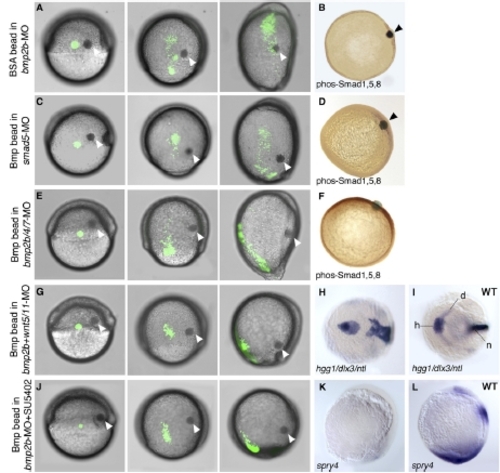Fig. S1
|
The Movement-Inducing Effect of the Bmp Beads Requires Smad5, but Is Independent of Endogenous Bmp2b/4/7 and of Noncanonical Wnt and Fgf Signaling. (A, C, E, G, and J) Live embryos treated as indicated on the left side of each row, at three different stages of gastrulation: shield stage (column 1), directly after bead implantation and subsequent fluorescein-uncaging of a group of lateral mesodermal cells; at 80% epiboly stage (column 2); and tailbud stage (column 3). Dorsal is to the right, anterior to the top. Implanted BSA beads (A, B) and Bmp beads (other panels) are indicated by arrowheads. (B, D, and F) Anti-phosphorylated Smad1/5/8 immunostainings at 80% epiboly, vegetal view, dorsal to the right. (A and B) Lateral mesodermal cells of bmp2b morphants do not respond to control BSA beads. (C–F) smad5 morphants do not respond to Bmp beads (C and D), whereas bmp2b/bmp4/bmp7 triple morphants do (E and F), indicating that the effect of exogenous Bmp requires transcriptional activation of Bmp target genes but is independent of the transcriptional positive feedback loop of Bmp signaling. (G–L) bmp2b morphants respond to the Bmp beads even after coinjection of wnt5 and wnt11 MOs (G) and after treatment with SU5402 (J), indicating that the effect is independent of noncanonical Wnt and Fgf signaling. (H and I) A bmp2b/wnt5/wnt11 triple morphant sibling (H) and a wild-type control (WT; [I]) not implanted with beads, after whole-mount in situ hybridization for the hatching gland marker hgg1 (h), the neural crest marker dlx3 (d), and the notochord marker ntl (n); tailbud stage, animal view, dorsal to the right. The triple morphant lacks dlx3 expression, resulting from the dorsalization caused by loss of Bmp2b, and strongly impaired convergent extension movements, caused by the loss of Wnt5 and Wnt11, as reflected by the broader notochord and the reduced anteriorposterior distance between hatching gland anlage and notochord. (K and L) bmp2b morphant treated with SU5402 (K) and wild-type control (WT; [L]) after in situ hybridization for sprouty4; lateral view, dorsal to the right, anterior at the top. The SU5402-treated bmp2b morphant lacks sprouty4 expression, indicating loss of Fgf signaling. |

